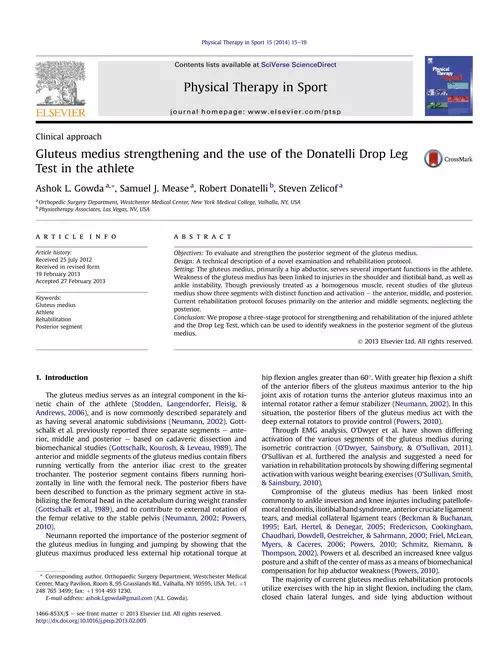
Gluteus medius strengthening and the use of the Donatelli Drop Leg
Setting: The gluteus medius, primarily a hip abductor, serves several important activation with various weight bearing exercises (O'Sullivan, Smith,.
adsPart of the document
Objectives:To evaluate and strengthen the posterior segment of the gluteus medius.
Design:A technical description of a novel examination and rehabilitation protocol.
Setting:The gluteus medius, primarily a hip abductor, serves several important functions in the athlete.
Weakness of the gluteus medius has been linked to injuries in the shoulder and iliotibial band, as well as
ankle instability. Though previously treated as a homogenous muscle, recent studies of the gluteus
medius show three segments with distinct function and activationethe anterior, middle, and posterior.
Current rehabilitation protocol focuses primarily on the anterior and middle segments, neglecting the
posterior.
Conclusion:We propose a three-stage protocol for strengthening and rehabilitation of the injured athlete
and the Drop Leg Test, which can be used to identify weakness in the posterior segment of the gluteus
medius.
?2013 Elsevier Ltd. All rights reserved.1. Introduction
The gluteus medius serves as an integral component in the ki-
netic chain of the athlete (Stodden, Langendorfer, Fleisig, &
Andrews, 2006), and is now commonly described separately and
as having several anatomic subdivisions (Neumann, 2002). Gott-
schalk et al. previously reported three separate segmentseante-
rior, middle and posteriorebased on cadaveric dissection and
biomechanical studies (Gottschalk, Kourosh, & Leveau, 1989). The
anterior and middle segments of the gluteus medius containfibers
running vertically from the anterior iliac crest to the greater
trochanter. The posterior segment containsfibers running hori-
zontally in line with the femoral neck. The posteriorfibers have
been described to function as the primary segment active in sta-
bilizing the femoral head in the acetabulum during weight transfer
(Gottschalk et al., 1989), and to contribute to external rotation of
the femur relative to the stable pelvis (Neumann, 2002;Powers,
2010).
Neumann reported the importance of the posterior segment of
the gluteus medius in lunging and jumping by showing that the
gluteus maximus produced less external hip rotational torque athipflexion angles greater than 60?
. With greater hipflexion a shift
of the anteriorfibers of the gluteus maximus anterior to the hip
joint axis of rotation turns the anterior gluteus maximus into an
internal rotator rather a femur stabilizer (Neumann, 2002). In this
situation, the posteriorfibers of the gluteus medius act with the
deep external rotators to provide control (Powers, 2010).
Through EMG analysis, O'Dwyer et al. have shown differing
activation of the various segments of the gluteus medius during
isometric contraction (O'Dwyer, Sainsbury, & O'Sullivan, 2011).
O'Sullivan et al. furthered the analysis and suggested a need for
variationin rehabilitationprotocolsbyshowingdiffering segmental
activation with various weight bearing exercises (O'Sullivan, Smith,
& Sainsbury, 2010).
Compromise of the gluteus medius has been linked most
commonly to ankle inversion and knee injuries including patellofe-
moraltendonitis,iliotibialbandsyndrome,anteriorcruciateligament
tears, and medial collateral ligament tears (Beckman & Buchanan,
1995;Earl, Hertel, & Denegar, 2005;Fredericson, Cookingham,
Chaudhari, Dowdell, Oestreicher, & Sahrmann, 2000;Friel, McLean,
Myers, & Caceres, 2006;Powers, 2010;Schmitz, Riemann, &
Thompson, 2002). Powers et al. described an increased knee valgus
postureand a shiftofthe centerofmassasameansofbiomechanical
compensation for hip abductor weakness (Powers, 2010).
The majority of current gluteus medius rehabilitation protocols
utilize exercises with the hip in slightflexion, including the clam,
closed chain lateral lunges, and side lying abduction without*Corresponding author. Orthopaedic Surgery Department, Westchester Medical
Center, Macy Pavilion, Room 8, 95 Grasslands Rd., Valhalla, NY 10595, USA. Tel.:þ1
248 765 3499; fax:þ1 914 493 1230.
E-mail address:ashok.l.gowda@gmail.com(A.L. Gowda).Contents lists available atSciVerse ScienceDirect
Physical Therapy in Sport
journal homepage: www.elsevier.com/ptsp
1466-853X/$esee front matter?2013 Elsevier Ltd. All rights reserved.
http://dx.doi.org/10.1016/j.ptsp.2013.02.005
Physical Therapy in Sport 15 (2014) 15e19
extension. A shortened lever arm with hip extension changes the
gluteus medius angle of pull, thus requiring the abductor muscle to
develop greater force and recruit all segments to counterbalance
the effect of gravity (Neumann, 2002). Additionally, Philippon re-
ported significant gluteus medius weakness and concurrent iliop-
soas tendonitis in patients undergoingflexion rehabilitation
activities (Philippon, Decker, Giphart, Torry, Wahoff, & LaPrade,
2011).


